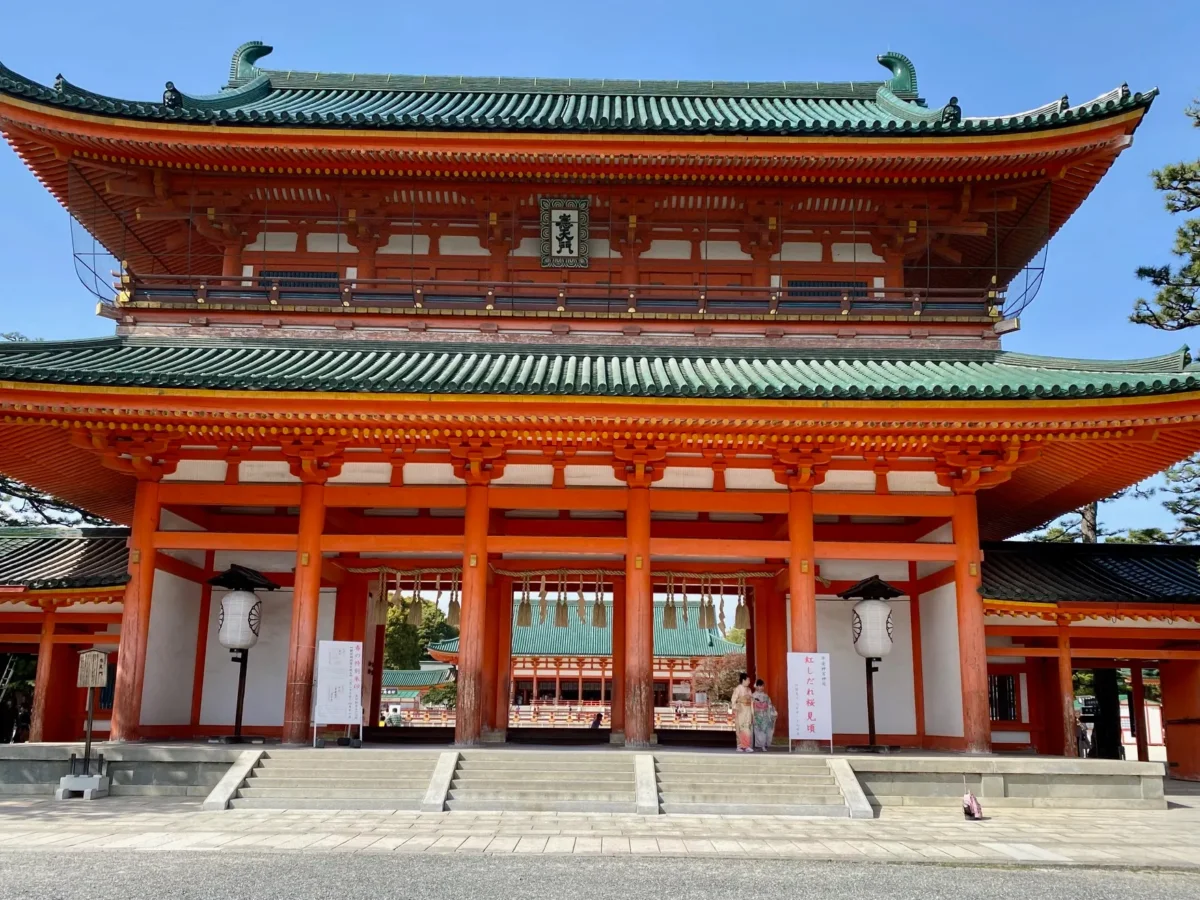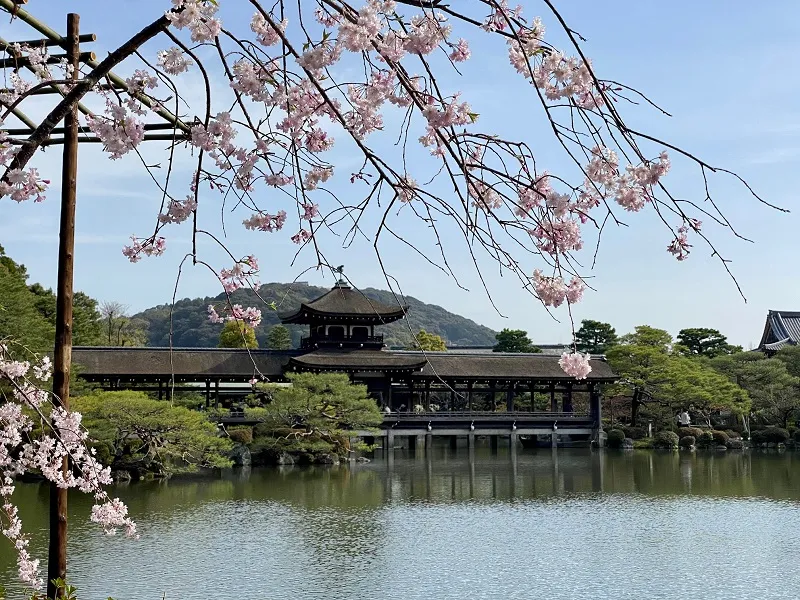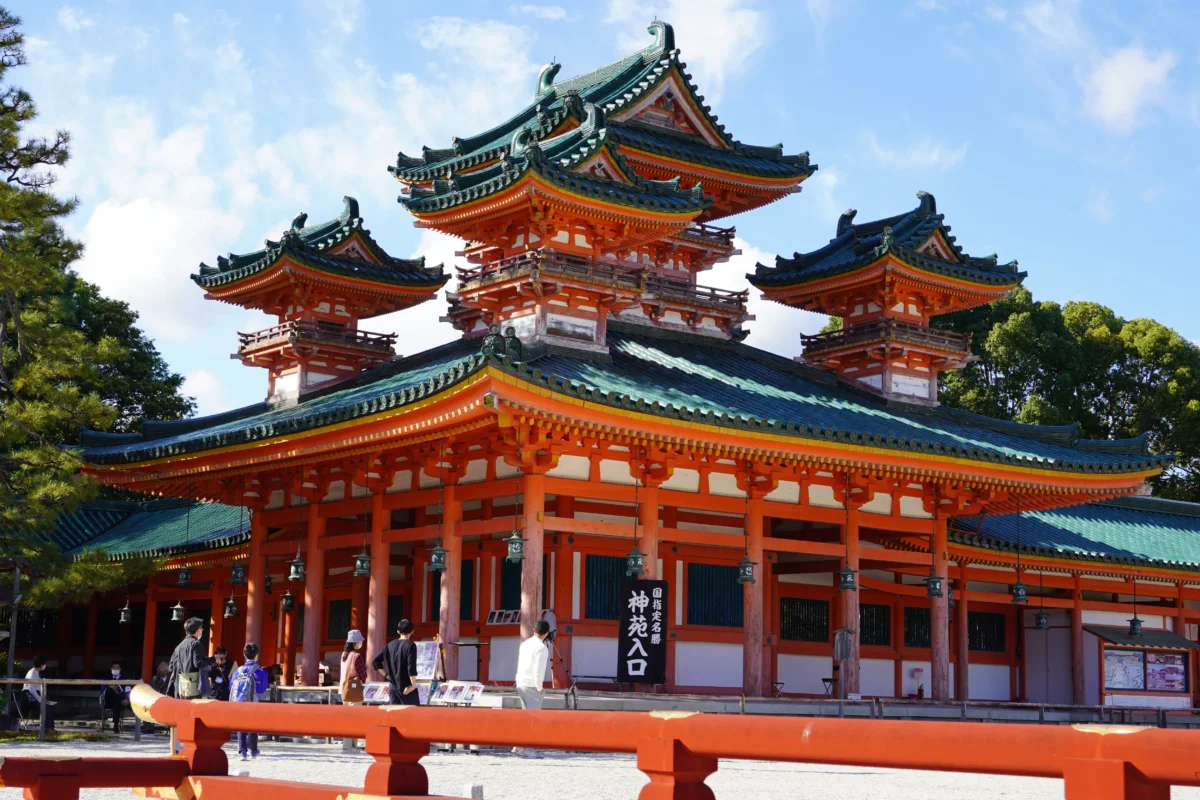
What is Heian Shrine?
Heian Shrine (平安神宮) is a striking Shinto shrine located in central Kyoto, known for its towering red torii gate and its vast open grounds. Built in 1895 to commemorate the 1100th anniversary of Kyoto’s founding as Japan’s capital (then called Heian-kyō), the shrine is dedicated to two emperors: Emperor Kanmu and Emperor Kōmei.
Unlike many shrines in Kyoto that date back centuries, Heian Shrine is relatively modern. Still, it captures the elegance of the ancient capital through its architecture, which replicates the design of the original Heian-period Imperial Palace on a smaller scale.
Its massive torii gate, peaceful gardens, and spacious courtyards make it a popular stop for both tourists and locals, especially during seasonal festivals like the Jidai Matsuri in October.
History of Heian Shrine

Heian Shrine (平安神宮), though it appears ancient, is actually a relatively modern Shinto shrine built in 1895 to commemorate the 1100th anniversary of Kyoto’s founding as Japan’s imperial capital. The shrine was constructed to honor the spirits of two emperors—Emperor Kanmu, who established Heian-kyō (now Kyoto), and Emperor Kōmei, the last emperor to reside in the city before the capital moved to Tokyo.
Its main structures were designed as a scaled-down replica of the original Imperial Palace from the Heian period (794–1185), reflecting Kyoto’s classical architectural aesthetics. Despite being damaged by fire in 1976, the shrine was quickly restored thanks to public support, and it continues to serve as a symbol of Kyoto’s imperial legacy.
What to See at Heian Shrine
The Giant Torii Gate

Before even reaching the shrine grounds, you’ll pass under one of the most iconic torii gates in Japan. Standing at 24.4 meters tall, this vibrant vermilion structure dominates the Okazaki district skyline. Although no longer the tallest torii in Japan, it remains the highest in Kyoto and was designed with anti-earthquake features. It leads visitors down a ceremonial approach toward the shrine’s grand main hall.
Shin-en Garden (神苑)

Spanning over 33,000 square meters, Shin-en Garden is one of the finest Meiji-era strolling gardens in Japan. Designed by the famed landscape artist Jihei Ogawa VII, the garden encircles the shrine buildings and is divided into four distinct sections: East (Higashi), Central (Naka), West (Nishi), and South (Minami).
Each section showcases seasonal beauty—cherry blossoms in spring, irises in early summer, fiery foliage in autumn, and snow-blanketed pines in winter. Designated a National Place of Scenic Beauty, the garden was crafted to reflect a thousand years of Kyoto’s aesthetic evolution. Walking its tranquil paths feels like entering the refined world of Heian aristocracy.
The Four Guardian Beasts
Heian Shrine’s architecture reflects strong influences from Chinese cosmology, including representations of the four cardinal guardian spirits:
- Seiryū (Blue Dragon) of the East
- Byakko (White Tiger) of the West
- Suzaku (Vermilion Bird) of the South
- Genbu (Black Tortoise-Snake) of the North
You’ll find references to these beasts carved into bronze lanterns, decorating the corridors, and even in the names of the shrine towers: Sōryūrō and Byakkorō. These symbolic elements add depth to the shrine’s spiritual atmosphere—and make great details to notice as you explore.
How to Get to Heian Shrine
By Train and Walk
- From Kyoto Station: Take the Karasuma Line to Karasuma Oike Station, transfer to the Tozai Line, and get off at Higashiyama Station. From there, it’s about a 10-minute walk to the shrine.
By Bus
- Take Kyoto City Bus #5 or #100 from Kyoto Station. Get off at Okazaki Koen / Bijutsukan, Heian Jingu-mae (岡崎公園 美術館・平安神宮前). The shrine is just a 5-minute walk from the bus stop.
By Car or Taxi
- There is no parking lot directly attached to the shrine, but coin-operated lots are available nearby in the Okazaki Park area.
Q&A – Heian Shrine Travel Tips
Is Heian Shrine worth visiting?
Yes. Heian Shrine is one of Kyoto’s most photogenic sites, known for its giant vermilion torii gate, peaceful gardens, and stunning seasonal beauty—especially during cherry blossom and autumn foliage seasons.
Do you need to pay to enter Heian Shrine?
Entrance to the shrine grounds is free. However, entry to the Shin-en Garden requires a small fee:
• Adults: ¥600
• Children: ¥300
How long should I spend at Heian Shrine?
Allow 45 minutes to 1 hour to explore the shrine grounds and admire the architecture. If you plan to stroll through the Shin-en Garden or take photos, you may want to stay longer—up to 90 minutes.
What’s the best season to visit?
Spring and autumn are ideal. In early April, the garden’s cherry blossoms are in full bloom. In November, maple trees provide vibrant fall colors. Early mornings are best to avoid crowds.
Can I combine Heian Shrine with other nearby attractions?
Absolutely. It’s located in the Okazaki area, close to:
• Kyoto City Zoo
• Kyoto Municipal Museum of Art
• Nanzen-ji Temple
• Philosopher’s Path
All are within walking distance.
Visitor Info
Address
97 Okazaki Nishitennocho, Sakyo Ward, Kyoto, 606-8341, Japan
(京都市左京区岡崎西天王町97)
Opening Hours
- Shrine Grounds: 6:00 AM – 5:30 PM
- Shin-en Garden: 8:30 AM – 5:00 PM (last entry: 4:30 PM)
Admission
- Shrine: Free
- Shin-en Garden: • Adults: ¥600 • Children: ¥300
Language Support
- Basic English signage available
- English-language pamphlets may be available at the entrance
Facilities
- Restrooms
- Small souvenir shop
- Benches and shaded rest areas